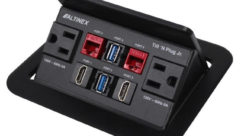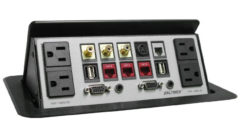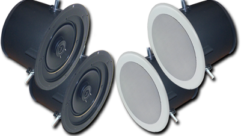
Rise Of The Modern AV Cart
Today’s learning environments often revolve around a highly sophisticated, flexible, continually evolving tool called the teaching station.
Station or Cart?Consider the UserSuit the Needs
Once upon a time, few things were more welcome in a classroom than the arrival of the AV cart. It signaled good times, beginning with a few minutes of face-making behind the teacher’s back while he or she worked to get everything up and running. Those times are gone now, and the familiar, bare-necessities AV cart may be coasting toward extinction.
Instead, today’s learning environments often revolve around a highly sophisticated, flexible, continually evolving tool called the teaching station. No simple lectern, a teaching station is a command post from which lecturers can call on a wide variety of video, computer, and other resources to maximize their presentation effectiveness. Achieving that goal, however, requires careful thought and attention to user needs at every stage of the design.
What goes into designing a successful teaching station?
John McKittrick, a systems sales specialist with AVI Midwest, puts a teaching station’s electronics to the test. McKittrick says there’s no rocket science behind creating an effective station that is well-suited to individual user needs.
“It’s not rocket science,” says John McKittrick, systems sales specialist at AVI Midwest in Bensonville, Ill., of designing an effective teaching station. Maybe not, but some fundamental decisions have to be made.
The basic AV cart usually features a TV monitor and some kind of video player. While this setup is morphing into a more powerful and versatile resource, the line between “cart” and “station” remains. So the first critical design decision is which kind of resource the user wants.
The key difference, of course, is mobility, but that’s not the only distinction. “A teaching station is used to present from, while an AV cart is not,” says Cindy Weinschreider, senior marketing manager at Bretford, a Chicago maker of lecterns, media furniture, and related products. “A teaching station needs to fit a variety of users and hold all the equipment that a typical presenter would need, while a cart can be strictly for utility, to move stuff from one place to another.”
Tony Mines, vice president of solutions at Tandberg in Reston, Va., notes some other factors. “An AV cart, which is designed to support peripheral devices such as document cameras, does not have a working surface and is generally shorter than a teaching station,” he says, which lets it be moved without any issue of it tipping over.
Jim Fisher, product manager at Bretford, says that in most cases, moving a teaching station would be awkward because of its size and contents. Adding functionality often shapes the decision between mobile and stationary options.
“If you have a PC, a DVD player, a projector, all of that equipment gets quite heavy,” says Wendy Long, CTS, director of marketing at Da-Lite Screen Co. in Warsaw, Ind. “You may also need a fixed location for cabling reasons. In a lecture hall environment, with a fixed install projector, they may have all the cabling designed to be connected to a station.”
Fixed projectors, often ceiling mounted, offer several advantages over a more mobile solution. “When you have a projector on the station itself, the instructor can’t walk in front of it, or if you start shaking the cart, for example by writing, you shake the image as well,” says Michael Dessaso, vice president at Matrix Ingenuity in Sacramento, Calif. “Then you have to run power, and you need an aisle space wide enough so nobody’s view is blocked.”
Carrying projectors and other devices on a mobile station adds another disadvantage. “You have a tail of cables to deal with,” says Dessaso. Even though connecting these cables is easier than ever, it’s extra work that can stand in the way of optimum station use.
Video Learning Tools Give Students an Edge
Credit:
One of the most popular enhancements for a contemporary teaching station is an ability to capture video in real time, making it immediately available to students either over the Internet or in an easily portable form. Until recently, that has been no small challenge, but Carlow University in Pittsburgh has shown how easy and popular this capability has become.
Carlow requires each student to create an electronic portfolio, including video clips of speeches given in class among other content. The school recently opted for a new approach using MediaPOINTE Digital Media Recorders from Advanced Media Design (shown here) which has “positively changed the entire way we record and distribute videos,” says Karen Sturgeon, assistant vice president for IT at Carlow.
“Before, our AV cart had a video camera, a copying device to burn CDs, a microphone, and a VCR so they could record a backup tape, along with other hardware and wires connecting everything,” says Katie Bartus, Carlow’s manager of technical and media services. That led to lengthy delays while CDs were produced, and offered no way of archiving videos to replace CDs that were lost or damaged.
Kim Dillard, director of marketing at AMD, says recording video directly to digital memory has been the solution for Carlow and other clients. “They just plug in a camera and a mic, and they’re up and running,” she says. The result is “a file that can immediately be posted on any network. People can get it from the network or log in directly to the unit, or download directly onto a DVD or CD writer or even a USB drive.”
All of this proceeds at the speed of digital file transfers rather than CD burning, so it’s very fast, and an archive copy can be retained for easy duplication in the future. “The price starts at about $5,000 and goes up to around $18,000,” says Dillard, explaining that the higher prices buy more inputs, better definition, and a variety of other enhancements. The entry-level device provides a single S-Video of composite input and can record a single video source. At higher levels with multiple inputs, users can accommodate a wider range of sources and compose more sophisticated, finished programs.
Although the device could be a do-it-yourself install, Dillard notes that AV integrators generally are involved, especially since the video recording capability is often an add-on to a room design already under way. Once installed, though, it’s easy for an unskilled user to manage. “It’s more expensive than a CD burner or VHS recorder,” says Dillard, “but they save money by not needing an AV technician in the room to help them burn CDs.” The Digital Media Recorder requires a single rack space and is easy to install. Echoing the sentiments of other specialists in the teaching station arena, says Dillard, “We wanted to make it as easy as possible.”
John McKeon is an independent consultant and writer in the Washington D.C. area. He can be reached at [email protected].
Mines notes a distinction that he finds even more critical: Teaching stations are generally linked to a distance learning or videoconferencing capability. When the teacher is in one room talking not only to students in the same room but to others at various locations, it’s a strong argument for a fixed teaching position supported by video cameras, displays, and an Internet connection to bring teacher and students together across the miles.
Once it’s clear that a teaching station is the correct route, the design process begins. What’s needed next is a complete knowledge of who will use the station and how. “The first thing is to understand the needs of the person doing the teaching,” says McKittrick. This encompasses not only what kind of media will be used most often and how instructors prefer to access it, but also the most fundamental elements of station design.
“If the requirement is very heavily oriented toward a particular type of technology, such as computer or software training, for example, it may be more prudent to design a station where the teacher is seated rather than standing,” says Mines.
The teaching environment can vary widely, says Mines. “If you were teaching an MBA course, the style and the students are very different from teaching basic reading and writing skills in a K-12 environment,” he says. “The design must allow for teaching style nuances, or it simply will not work.”
For Long, the requirements start with the media, for instance what equipment will be used, a basic overhead projector or a PC and a projector? Each added capability, she says, means “more space, more consideration of electrical needs, cable management, and so forth.”
Although higher-end, fixed teaching stations have been more common in higher education, some elementary school systems have gone far in this direction. Lance Ford, technology coordinator at the Howe/Hodgen Public Schools in rural Oklahoma, says his system’s reliance on distance learning and virtual field trips has helped drive a move to install very capable stations in its classrooms. About 70 percent of the system’s classrooms have videoconferencing capability, he says.
“Everything needs to be easy to get to, not one component here and one over there,” says Ford. “The teacher needs a centralized location from which to originate instruction. Our podium is self-contained, has a DVD player and VCR on it, plus a document camera, laptop connection, a camera trained on the station, and all the control buttons right there for the teacher.”
Ford adds, “The whole idea that they’re going to come down to the office and check it out when they need it is over. We’re moving away from the idea that we’re going to roll it in, wow everybody, and roll it back out.”
McKittrick says teaching station designs start with some basic templates, but most are customized to some degree. “You try to make things as standard as possible, but the equipment is always changing. The cutouts for monitors are never quite exact, and there are add-ons to allow for things such as a PC or a keyboard shelf,” he says.
The starter configuration of a teaching station usually includes a dedicated computer, a work surface, a space to plug in a laptop computer, and access to some kind of video playback, which these days is a DVD player somewhere on the station, says McKittrick.
Another must is an easy laptop connection, including both power and network connectivity, usually via an Ethernet outlet. “Most frequently, the instructor will walk in with his laptop and want a very simple plug-in, and that’s all he should have to worry about,” says Bretford’s Fisher.
Protecting the additional devices, which are often lightweight and compact, dictates lockable doors or some means of connecting the devices to their shelves. “There’s usually some kind of voice lift,” says McKittrick, “whether it’s a gooseneck or wireless microphone.”
Mobile AV cart users who need sound enhancement typically require speakers either built into the cart or that are easily attached; they may want a wireless mic option as well, says McKittrick. “We also see a lot of document cameras, or access points for document cameras,” he says.
McKittrick says his firm’s designs start at about $4,500 for a fixed teaching station without electronics. Top-of-the-line models from firms such as Da-Lite and Bretford are in that neighborhood, and McKittrick says these are highly capable pieces of furniture, even though they often must be tweaked for particular uses.
Tall teachers, short teachers, teachers who like to walk around, teachers who stay put. Teachers who sit, stand, those who use wheelchairs or need controls marked in Braille. All kinds of needs must be met in designing a teaching station, including the needs of multiple users.
A good teaching station often includes automatic height adjustment, so a teacher can use it while sitting or standing, along with easily adjustable shelves for convenient access to all devices. Depending on the weight of the components, these shelves may be motorized and have preset positions, so a simple button push changes the configuration. “We always try to accommodate the Americans with Disabilities Act,” says Fisher, noting that these accommodations are often highly individualized.
Adding capabilities to a station can create some esthetic and ergonomic problems, says Dessaso. “When you have a very large lectern, you have the instructor almost hidden behind the device, which is a barrier in a sense,” he says. “You don’t necessarily want the teacher to be encumbered behind the device.”
One man’s frill may be another man’s necessity, but when it comes to teaching stations, designers can offer users plenty of features that fall somewhere in between.
Mines sees frequent interest in adding interactive whiteboards to stations, especially in distance learning applications, because capturing the instructor’s notes on an interactive board “gives far better results than pointing a camera at a standard whiteboard.” Not only will the board’s contents be crisper and clearer, but notations can be captured electronically at both locations, he says.
He also notes interest in some event-triggered features. For example, says Mines, a camera can “move to follow the instructor, so that when he stands behind the station, he is automatically seen by the remote sites. This can be expanded, so that when the teacher steps close to the electronic whiteboard, it automatically transmits the image from it, and when he steps away, the rear camera automatically shows a view of the teacher next to the whiteboard.”
Added features that McKittrick finds popular are cutouts for customized touchpanels, clock timers, and lighting controls. Dessaso says his firm’s customers have been enthusiastic about adding wireless Bluetooth control pads that the instructor can use anywhere in the room to control the computer GUI. In addition, he says, customers often want the ability to record video and audio and have the resulting files available for immediate access by students. (See sidebar.)
There are as many approaches to teaching station design as there are teachers and classrooms, and integrators working with education buyers need to keep a wide range of options open. Dessaso says one thought recurs like a mantra: Keep things “as brazenly easy as you can imagine.”










